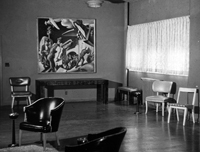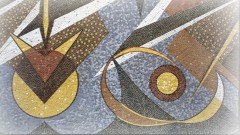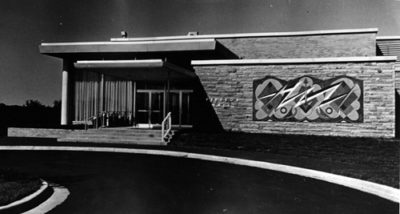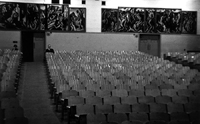Statues, paintings, and a mosaic — now you see them, now you don’t
“Lost” may be too strong a word. Of the three pieces of art described here, only one is – strictly speaking – lost or at least misplaced. A second art work was removed from an aging UMKC building many years ago and taken to the Nelson-Atkins Museum of Art, where it remains today. And the third work of art, delivered to the university under extraordinary circumstances, is…well, hidden.
Gone… or at least misplaced
In April 1940, a fountain, comprising a large pool and three statues, was installed in front of today’s Manheim Hall. A gift of the University of Kansas City’s second graduating class, the fountain’s Three Graces were sculpted by Walter Wallace Rosenbauer, an instructor at the Kansas City Art Institute.
Through the years, the three nude sculptures became the focus of student pranks, especially at the end of each academic year during commencement time.
In 1973, the Three Graces fountain was disassembled, and the statues put into storage.
Although the records are unclear, at some point the statues may have been relocated to a second storage facility.
What is known, however, is that in 1983 a secretary at the History Department wrote a memo saying,” The three female statues (nudes) which were in the center of the fountain behind Scofield Hall, which now has been covered over with a large collection of rocks, are now located in the basement of 5212 Rockhill (the former History Dept.)”
A recent search for the statues by UMKC Archives representatives was unsuccessful. Because the statues are small – the Three Graces are diminutive in size and possibly covered in padding – they may have been easily overlooked.
Gone but not forgotten

Benton’s painting, “Bootleggers,” also a gift to the university hung in the University Theatre’s Green Room. In 1971, Reynolda House, Museum of American Art, Winston-Salem, N.C., acquired the painting.
On May 12, 1945, Thomas Hart Benton and his wife gave UKC a 10-panel mural in honor of their son, Thomas P. Benton, a student at the university before entering military service in World War II (WWII).
The oil-on-canvas mural was approximately 6 feet high and 60 feet long. Originally conceived as a work with more than 50 panels, Benton had only completed 18 panels of the American Historical Epic mural by the end of his life in 1975.
Painted between 1919 and 1924– while the artist lived in New York– the 10 panels marked the beginning of Benton’s career as a muralist.
The panels were installed in the UKC/UMKC playhouse, a recently relocated and renovated government surplus building, which had served as the post theater at Camp Crowder during WWII. The 10 panels lined the back walls of the theatre.
Today the 10-panel mural hangs in the Atkins Auditorium at the Nelson-Atkins Museum of Art, bequeathed by the artist to the gallery in 1975.
Walled up and hidden
 In 1961, Elmer F. Pierson, chairman of the Vendo Company, commissioned Henry E. Scott III to create a mosaic for the outer, southwest wall of the recently completed UKC University Center.
In 1961, Elmer F. Pierson, chairman of the Vendo Company, commissioned Henry E. Scott III to create a mosaic for the outer, southwest wall of the recently completed UKC University Center.
Construction of the 8-by-18-feet mosaic was done at Scott’s home on Martha’s Vineyard. Although the mosaic’s 72,000 thumbnail-size pieces of Venetian glass were scheduled to arrive from Europe in stages, the artist received the entire shipment at once. As a result, he and his brother quickly built an 18-by-24-feet room addition to accommodate the glass tiles and the mosaic’s construction.
But the sudden arrival of 72,000 tiles was only the start of Scott’s problems.
The process required gluing the glass to paper. Made of corn syrup, flour and water, the glue attracted swarms of insects. Every morning before the day’s work began, Scott and his wife, Alice, fumigated the studio.
In early September, category-four Hurricane Ester forced the evacuation of Martha’s Vineyard. The artist hurriedly built a wooden box, cut the nearly completed mosaic into sections and packed it in the box. Scott then loaded the box into his station wagon and, along with Alice and three dogs, took the last ferry off the island and headed to Kansas City.
On October 30, 1961, the day of the mosaic’s public unveiling, a Kansas City Star reporter described the work as “a color exercise, and as such is effective in decorating the fieldstone wall.”
The mosaic’s dominant colors were UKC’s school colors: blue and gold.
In the late 1980s, when University Center and Swinney Recreation were remodeled and the causeway between the two buildings was built, a new exterior wall was constructed for the University Center, repositioning the angle of the south wall in a way that enclosed the mosaic. The 72,000 pieces of Venetian glass are now hidden from view.
Photographs for this feature were provided by UMKC’s University Archives and the Western Historical Manuscript Collection.



